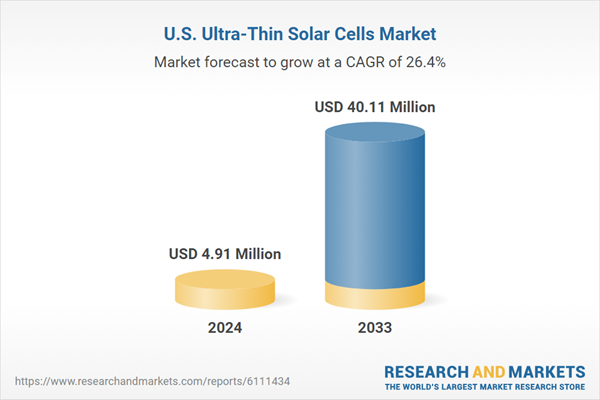Market Size & Trends
The U.S. ultra-thin solar cells market size was estimated at USD 4.91 million in 2024 and is projected to reach USD 40.11 million by 2033, growing at a CAGR of 26.42% from 2025 to 2033.In the U.S., ultra-thin solar cells are gaining traction as a lightweight and flexible photovoltaic solution, particularly suited for portable power sources, next-gen consumer electronics, and building-integrated solar applications.These cells offer significant design versatility and material efficiency advantages, making them ideal for curved surfaces and constrained environments. Strong federal and state-level incentives for solar adoption and increased investment in R&D by U.S.-based manufacturers and startups drive market growth. The rising demand for sustainable energy solutions in defense, aerospace, and smart infrastructure supports adoption. In addition, innovation hubs in California, Texas, and Massachusetts are fostering advancements in perovskite and organic photovoltaic materials, reinforcing the U.S. as a key player in the global ultra-thin solar technology landscape.
In the United States, ultra-thin solar cells are increasingly utilized in applications demanding lightweight construction, flexibility, and minimal spatial footprint. While traditional silicon-based panels dominate utility-scale installations, ultra-thin variants enable novel uses across consumer electronics, portable military systems, and BIPV solutions in urban infrastructure. Their adaptability to curved and non-traditional surfaces, including windows, facades, and fabrics, makes them a strategic fit for next-generation smart cities and defense technologies.
The combination of strong federal tax incentives, decarbonization mandates, and growing investments in distributed solar technologies creates a favorable environment for widespread adoption across public and private sectors.
U.S. Ultra-Thin Solar Cells Market Report Segmentation
This report forecasts revenue growth at country levels and provides an analysis of the latest industry trends in each of the sub-segments from 2021 to 2033. For the purpose of this study, the analyst has segmented the U.S. ultra-thin solar cells market report on the basis of material, end use, and region.Material Outlook (Revenue, USD Million, 2021 - 2033)
- Cadmium Telluride
- Copper Indium Gallium Selenide
- Perovskite Solar Cell
- Organic Photovoltaic
- Others
End Use Outlook (Revenue, USD Million, 2021 - 2033)
- Residential
- Commercial
Why should you buy this report?
- Comprehensive Market Analysis: Gain detailed insights into the global market across major regions and segments.
- Competitive Landscape: Explore the market presence of key players worldwide.
- Future Trends: Discover the pivotal trends and drivers shaping the future of the global market.
- Actionable Recommendations: Utilize insights to uncover new revenue streams and guide strategic business decisions.
This report addresses:
- Market intelligence to enable effective decision-making
- Market estimates and forecasts from 2018 to 2030
- Growth opportunities and trend analyses
- Segment and regional revenue forecasts for market assessment
- Competition strategy and market share analysis
- Product innovation listing for you to stay ahead of the curve
- COVID-19's impact and how to sustain in these fast-evolving markets
This product will be delivered within 1-3 business days.
Table of Contents
Chapter 1. Methodology and Scope
Chapter 2. Executive Summary
Chapter 3. Market Variables, Trends, and Scope
Chapter 4. U.S. Ultra-Thin Solar Cells Market: Material Estimates & Trend Analysis
Chapter 5. U.S. Ultra-Thin Solar Cells Market: End Use Estimates & Trend Analysis
Chapter 6. Competitive Landscape
List of Tables
List of Figures
Companies Mentioned
- First Solar, Inc.
- Ascent Solar Technologies, Inc.
- PowerFilm, Inc.
- Solar Frontier K.K.
- Kaneka Corporation
- Canadian Solar Inc.
- Mitsubishi Electric Corporation
- Hanwha Qcells
- Canadian Solar Inc.
- Trina Solar Limited
Table Information
| Report Attribute | Details |
|---|---|
| No. of Pages | 120 |
| Published | June 2025 |
| Forecast Period | 2024 - 2033 |
| Estimated Market Value ( USD | $ 4.91 Million |
| Forecasted Market Value ( USD | $ 40.11 Million |
| Compound Annual Growth Rate | 26.4% |
| Regions Covered | United States |
| No. of Companies Mentioned | 10 |









